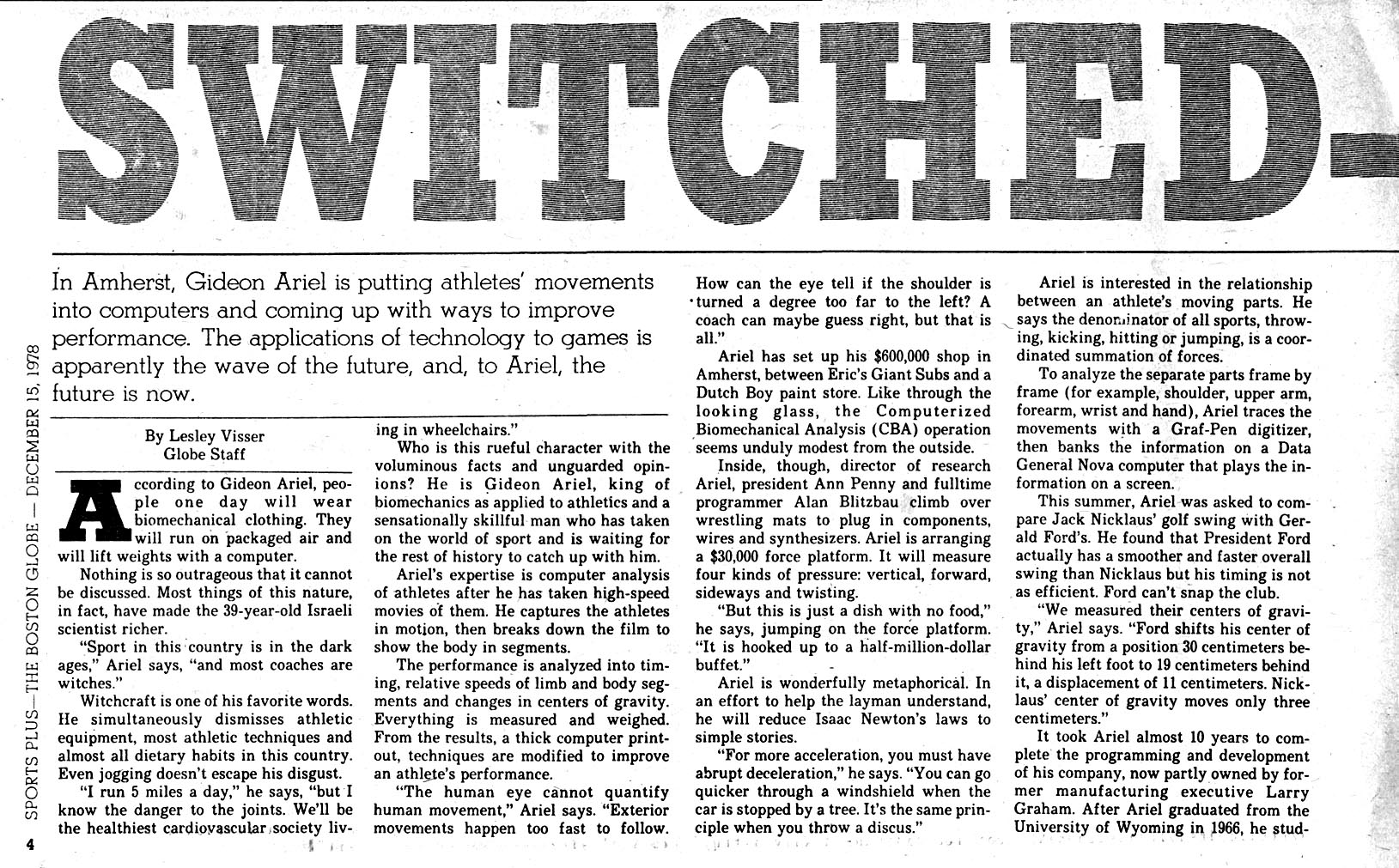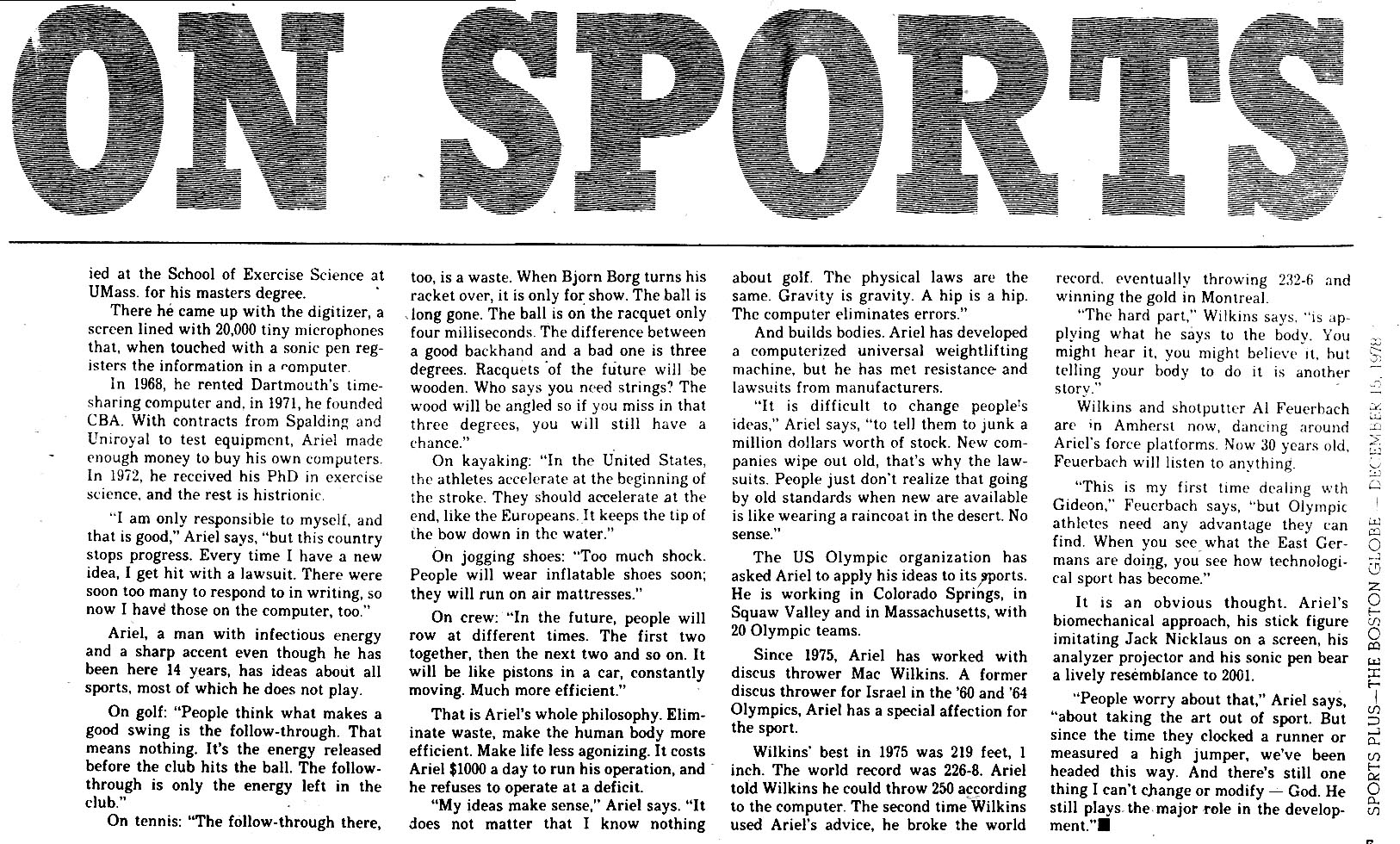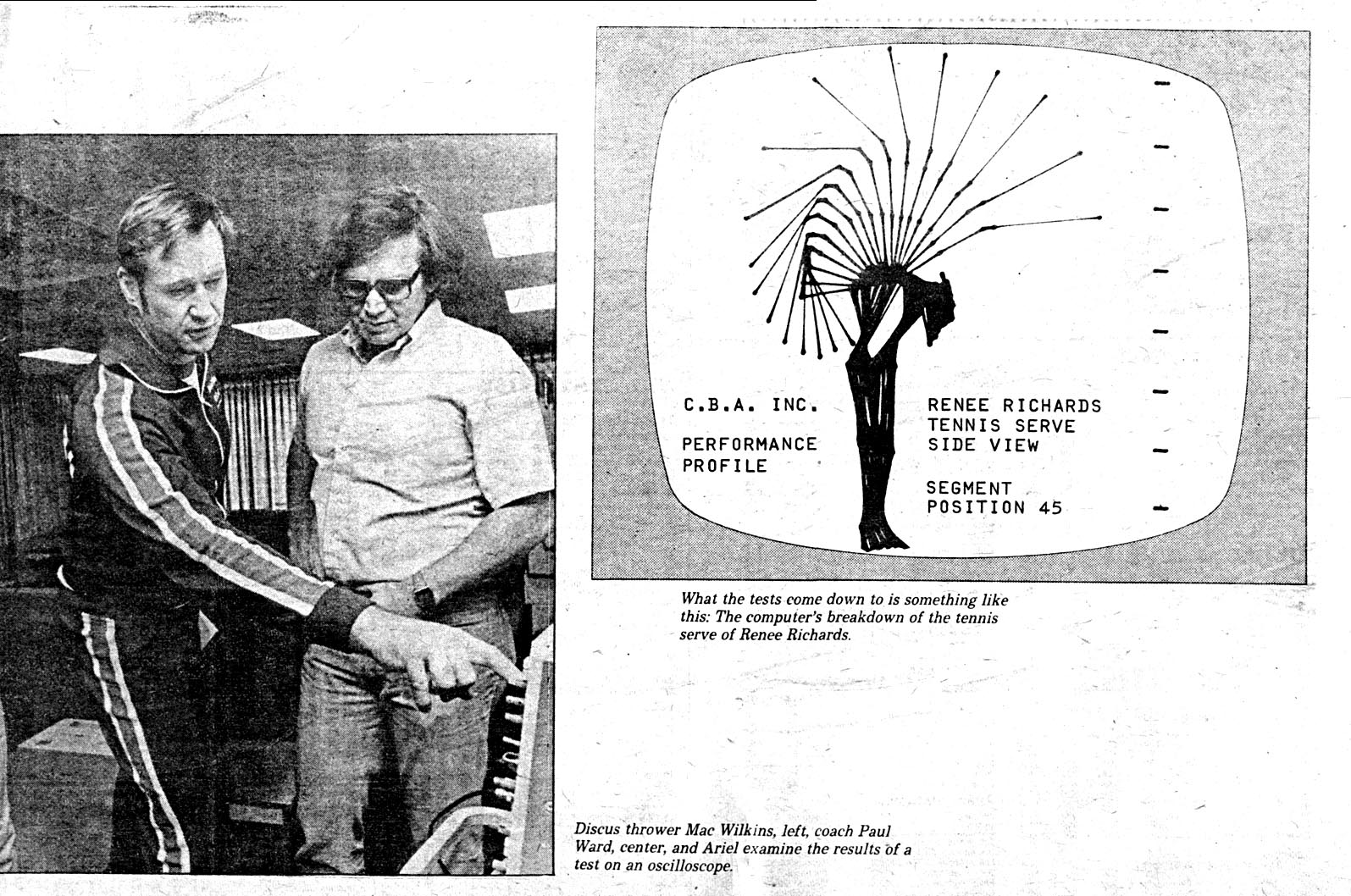Switched-On Sports
In Amherst, Gideon Ariel is putting athletes' movements into computers and coming up with ways to improve performance.
By Lesley Visser in The Boston Globe on Friday, December 1, 1978
Gideon Ariel: The Future of Sports Performance
Gideon Ariel, a 39-year-old Israeli scientist, is revolutionizing the world of sports through biomechanics and computer analysis. Ariel believes that the future of sports lies in technology, and he is leading the way with his innovative methods. He uses high-speed movies to capture athletes in motion, then breaks down the film to analyze the body in segments. This detailed analysis allows him to measure and weigh everything from timing and relative speeds of limb and body segments to changes in centers of gravity.
Ariel's company, Computerized Biomechanical Analysis (CBA), is based in Amherst. Despite its modest exterior, the company is a hub of innovation, with a $600,000 shop filled with cutting-edge technology. Ariel and his team use a range of tools, including a $30,000 force platform, to measure different types of pressure and improve athletes' performance.
Ariel's work has already yielded interesting results. For example, he was asked to compare the golf swings of Jack Nicklaus and Gerald Ford. His analysis found that while Ford has a smoother and faster overall swing, his timing is not as efficient as Nicklaus'.
Ariel's vision for the future of sports includes biomechanical clothing, running on packaged air, and lifting weights with a computer. He believes that the current state of sports in the country is in the dark ages and hopes his work will help bring about a new era of technological advancement in athletics.
Tip: use the left and right arrow keys
In Amherst, Gideon Ariel is putting athletes' movements into computers and coming up with ways to improve performance. The applications of technology to games is apparently the wave of the future, and, to Ariel, the future is now.
By Lesley Visser
Globe Staff
According to Gideon Ariel, people one day will wear biomechanical clothing. They will run on packaged air and will lift weights with a computer.
Nothing is so outrageous that it cannot be discussed. Most things of this nature, in fact, have made the 39-year-old Israeli scientist richer.
"Sport in this country is in the dark ages," Ariel says, "and most coaches are witches."
Witchcraft is one of his favorite words. Ile simultaneously dismisses athletic equipment, most athletic techniques and almost all dietary habits in this country. Even jogging doesn't escape his disgust.
"I run 5 miles a day," he says, "but I know the danger to the joints. We'll be the healthiest cardiovascular society liv
4 1. 1
ing in wheelchairs."
Who is this rueful character with the voluminous facts and unguarded opinions? He is Gideon Ariel, king of biomechanics as applied to athletics and a sensationally skillful man who has taken on the world of sport and is waiting for the rest of history to catch up with him.
Ariel's expertise is computer analysis of athletes after he has taken high-speed movies of them. He captures the athletes in motion, then breaks down the film to show the body in segments.
The performance is analyzed into timing, relative speeds of limb and body segments and changes in centers of gravity. Everything is measured and weighed. From the results, a thick computer printout, techniques are modified to improve an athlete's performance.
"The human eye cannot quantify human movement," Ariel says. "Exterior movements happen too fast to follow.
How can the eye tell if the shoulder is *turned a degree too far to the left? A coach can maybe guess right, but that is all."
Ariel has set up his $600,000 shop in Amherst, between Eric's Giant Subs and a Dutch Boy paint store. Like through the looking glass, the Computerized Biomechanical Analysis (CBA) operation seems unduly modest from the outside.
Inside, though, director of research Ariel, president Ann Penny and fulltime programmer Alan Blitzbau climb over wrestling mats to plug in components, wires and synthesizers. Ariel is arranging a $30,000 force platform. It will measure four kinds of pressure: vertical, forward, sideways and twisting.
"But this is just a dish with no food," he says, jumping on the force platform. "It is hooked up to a half-million-dollar buffet." -
Ariel is wonderfully metaphorical. In an effort to help the layman understand, he will reduce Isaac Newton's laws to simple stories.
"For more acceleration, you must have abrupt deceleration," he says. "You can go quicker through a windshield when the car is stopped by a tree. It's the same principle when you throw a discus."
Ariel is interested in the relationship between an athlete's moving parts. He says the denominator of all sports, throwing, kicking, hitting or jumping, is a coordinated summation of forces.
To analyze the separate parts frame by frame (for example, shoulder, upper arm, forearm, wrist and hand), Ariel traces the movements with a Graf-Pen digitizer, then banks the information on a Data General Nova computer that plays the information on a screen.
This summer, Ariel was asked to compare Jack Nicklaus' golf swing with Gerald Ford's. He found that President Ford actually has a smoother and faster overall swing than Nicklaus but his timing is not as efficient. Ford can't snap the club.
"We measured their centers of gravity," Ariel says. "Ford shifts his center of gravity from a position 30 centimeters behind his left foot to 19 centimeters behind it, a displacement of 11 centimeters. Nicklaus' center of gravity moves only three centimeters."
It took Ariel almost 10 years to complete the programming and development of his company, now partly owned by former manufacturing executive Larry Graham. After Ariel graduated from the University of Wyoming in 1966, he stud-





